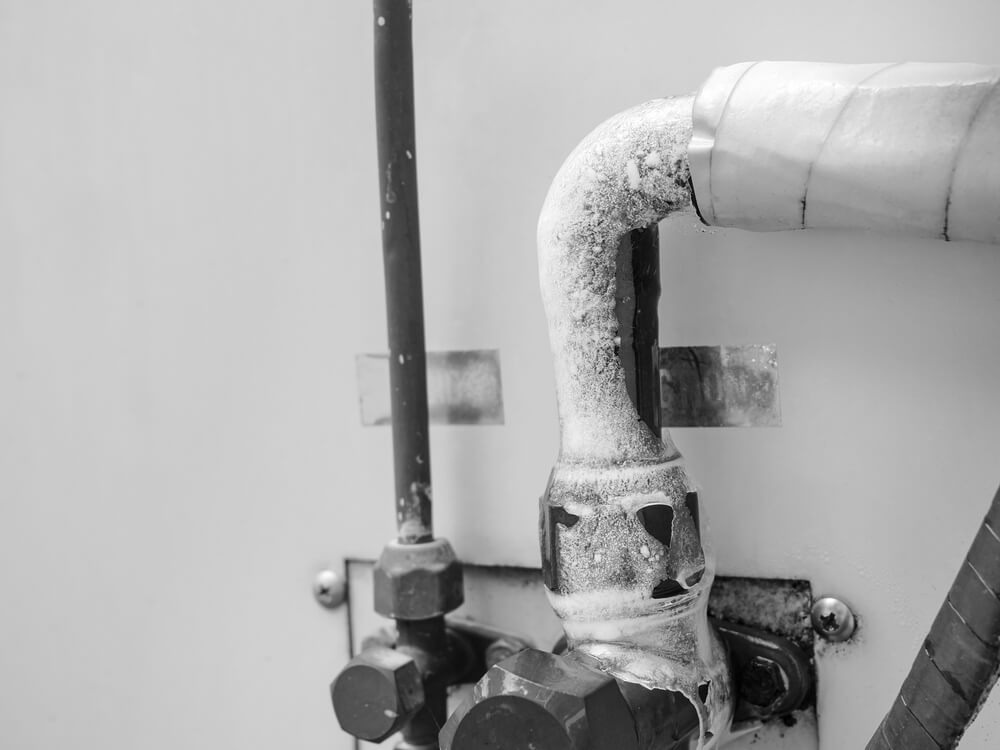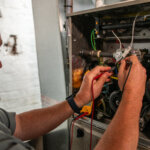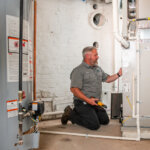Frozen pipes present significant challenges, particularly when they remain frozen for an extended period. At Jolly Plumbing, Drains, Heating, and Air, we understand the urgency and potential hazards that prolonged frozen pipes pose. We specialize in addressing these issues promptly and effectively to minimize damage and restore your plumbing system’s functionality.
Understanding the Risks of Prolonged Frozen Pipes
If you leave your pipes frozen for long periods — even as little as two days — you can increase their risk of bursting. It’s important to take immediate action when you see early signs of freezing.
How Long Can Pipes Stay Frozen Before Bursting?
Generally, pipes can withstand freezing temperatures for several hours, but beyond that, the risk of bursting amplifies significantly. Besides bursting, other risks that you can encounter when you leave your pipes frozen for two days include:
- Water damage
- Structural damage
- Mold and mildew growth
- Utility disruption
- Potential health hazards
- Property loss and damage
At Jolly Plumbing, we’ve encountered many different scenarios, and our expertise equips us to manage these situations adeptly.
Can Pipes Stay Frozen for Days?
If left unattended, your pipes may remain frozen for days, and here are the factors that can impact this outcome.
Inadequate Insulation
Insufficient or inadequate insulation around pipes, especially in unheated or poorly insulated areas such as basements, crawl spaces, or attics, allows cold temperatures to penetrate and maintain freezing conditions for longer periods.
Location of Pipes
Pipes located in exterior walls, near openings, or in areas where they’re exposed to cold drafts are more susceptible to freezing. Similarly, pipes situated underground or in areas without proper heating are prone to staying frozen for much longer durations.
Lack of Heating or Warm Air Circulation
Another factor to consider is that insufficient heating in the property or inadequate circulation of warm air around pipes can prevent them from thawing naturally. For instance, closed-off spaces, closed cabinet doors, or limited airflow impede the transfer of heat to the frozen pipes.
Length of Freezing Period
The duration of exposure to freezing temperatures directly impacts how long pipes remain frozen. If temperatures remain consistently below freezing for an extended period, the likelihood of pipes staying frozen for days increases significantly.
Water Flow or Pressure
Sometimes, frozen pipes prevent water flow or cause pressure buildup within the pipes. This pressure, in turn, can prolong the freezing as the trapped water remains in a frozen state, thereby worsening the risk of pipe bursts.
Structural Issues or Damage
Lastly, any structural issues within the plumbing system, such as cracks, leaks, or damaged pipes, can intensify the freezing problem. These issues can disrupt the flow of heat and exacerbate the freezing process, leading to pipes staying frozen for longer periods.
Immediate Actions To Mitigate Damage
When faced with frozen pipes, swift and decisive actions can significantly minimize potential damage and mitigate further complications within your plumbing infrastructure.
Should I Turn the Water Off if My Pipes Freeze?
When you discover frozen pipes, here are the steps you can take to prevent further damage.
1. Turn Off the Water Supply
As soon as you detect frozen pipes, shut off the main water supply to prevent further water from entering the frozen area. This step is crucial in reducing the risk of pipe bursts and consequent water damage.
2. Open Faucets
Then, open faucets connected to the frozen pipes. Doing so relieves pressure within the pipes, reducing the likelihood of them bursting once they thaw. When performing this step, be sure to keep both hot and cold water taps open to allow for drainage once the pipes start thawing.
3. Identify the Frozen Section
Next, determine the section of the pipe that’s frozen. Check for frost on visible pipes or areas where there is restricted water flow. By pinpointing the affected area, you can focus your thawing efforts for optimal results.
4. Apply Heat Safely
Use safe heating methods to thaw the frozen pipes. You can employ various techniques such as the following:
- Hairdryer: Direct warm air toward the frozen area, starting from the faucet and working your way toward the blockage.
- Towels soaked in hot water: Wrap these around the frozen pipe sections.
- Heating pads or space heaters: Apply heat cautiously to the affected area, avoiding direct contact to prevent damage.
5. Never Use Open Flames
Avoid using open flames, blowtorches, or high-heat devices to thaw pipes, as they pose fire hazards and can damage pipes, increasing the risk of leaks or bursts.
6. Monitor Thawing Progress
Continuously monitor the thawing process. As the ice begins to melt, water flow may gradually return. Make sure you’re present to address any leaks or issues that arise during the thawing process.
7. Call a Professional Plumber if Necessary
If you’re unable to thaw the pipes or if there’s a burst, contact a licensed plumber immediately for professional assistance. Expert plumbers, like us, possess the knowledge and tools to handle the situation effectively. So, don’t hesitate to get our plumbing services for professional assistance.
Thawing Frozen Pipes Safely
If you decide to thaw pipes on your own, be sure to practice precautions. Safety should remain your number one priority.
How Long Does It Take for Pipes To Unfreeze?
Usually, the time it takes for pipes to unfreeze varies based on several factors, including the degree of freezing and the methods used for thawing. In most cases, expect thawing to take several hours.
When thawing frozen pipes, here are safety measures you need to follow:
- Locate the frozen section by identifying areas with restricted water flow or visible frost buildup on pipes.
- Gradually apply heat, starting at the faucet, and progress toward the frozen section to safely thaw the pipes.
- Prevent damage by refraining from using open flames or high-heat sources during the thawing process.
- Continuously monitor the thawing process and persist until water flows freely from the affected pipes.
Should you need further instructions in unfreezing your pipes, here’s a comprehensive guide to help you out.
Final Thoughts
In summary, prolonged frozen pipes pose a significant threat to your plumbing system. For professional assistance, contact Jolly Plumbing. Our expertise and prompt service will help mitigate the risks and restore your plumbing system’s functionality.
We at Jolly Plumbing aim to be your trusted advisor during plumbing crises. Stay informed, take action promptly, and reach out for professional assistance when needed. Your proactive approach can save you from the potential havoc of leaving your pipes frozen for two days.




